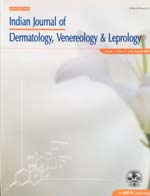
|
Indian Journal of Dermatology, Venereology and Leprology
Medknow Publications on behalf of The Indian Association of Dermatologists, Venereologists and Leprologists (IADVL)
ISSN: 0378-6323
EISSN: 0378-6323
Vol. 76, No. 3, 2010, pp. 259-262
|
 Bioline Code: dv10079
Bioline Code: dv10079
Full paper language: English
Document type: Research Article
Document available free of charge
|
|
|
Indian Journal of Dermatology, Venereology and Leprology, Vol. 76, No. 3, 2010, pp. 259-262
| en |
Clinicopathological study of itchy folliculitis in HIV-infected patients
Annam, Vamseedhar; Yelikar, B. R.; Inamadar, Arun C.; Palit, Aparna & Arathi, P.
Abstract
Background: Itchy folliculitis are pruritic, folliculo-papular lesions seen in human immunodeficiency virus (HIV)-infected patients. Previous studies have shown that it was impossible to clinically differentiate between eosinophilic folliculitis (EF) and infective folliculitis (IF). Also, attempts to suppress the intense itch of EF were ineffective.
Aims: The present study is aimed at correlating clinical, histopathological and immunological features of itchy folliculitis in HIV patients along with their treatment.
Methods: The present prospective study lasted for 36 months (September, 2005 to August, 2008) after informed consent, data on skin disorders, HIV status and CD4 count were obtained by physical examination, histopathological examination and laboratory methods.
Results: Of 51 HIV-positive patients with itchy folliculitis, the predominant lesion was EF in 23 (45.1%) followed by bacterial folliculitis in 21 (41.2%), Pityrosporum folliculitis in five (9.8%) and Demodex folliculitis in two (3.9%) patients. The diagnosis was based on characteristic histopathological features and was also associated with microbiology confirmation wherever required. EF was associated with a lower mean CD4 count (180.58 ± 48.07 cells/mm 3 , P-value < 0.05), higher mean CD8 count (1675.42 ± 407.62 cells/mm3) and CD8/CD4 ratio of 9.27:1. There was significant reduction in lesions following specific treatment for the specific lesion identified.
Conclusion: Clinically, it is impossible to differentiate itchy folliculitis and therefore it requires histopathological confirmation. Appropriate antimicrobial treatment for IF can be rapidly beneficial. The highly active antiretroviral therapy along with Isotretinoin therapy has shown marked reduction in the lesions of EF. Familiarity with these lesions may help in improving the quality of lives of the patients.
Keywords
Itchy folliculitis, histopathology, Infective folliculitis, HIV
|
| |
© Copyright 2010 Indian Journal of Dermatology, Venereology, and Leprology.
Alternative site location: http://www.ijdvl.com
|
|
